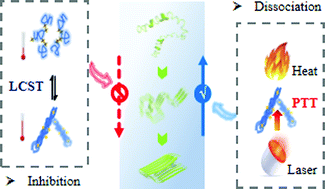Near-infrared irradiation controlled thermo-switchable polymeric photosensitizer against β-amyloid fibrillation†
Abstract
Photothermal therapy (PTT) is an emerging paradigm for the degradation of amyloid-β (Aβ) aggregations and has become an effective way of treating Alzheimer's disease (AD). A promising PTT therapeutic option requires control of at least two key functional aspects: controllable photoactivity and specific activation. In this work, a near-infrared (NIR)-activated thermo-switchable biopolymeric PTT agent was designed and synthesized by conjugating a molecular rotor-based boron dipyrromethene photosensitizer (BDP) to a temperature-responsive polymer backbone of biopolymeric hydroxypropyl cellulose (HPC). The as-synthesized BDP–HPC exhibited an ultra-high PCE of 78.1% along with prominent cycling stability of phase-transition behavior under NIR irradiation in the light of the lower critical solution temperature (LCST at 42.5 °C). Importantly, the NIR irradiation can manipulate the reversible phase transition behavior of the resultant BDP–HPC that reveals high effectiveness in inhibiting Aβ aggregation together with the obvious ability to dissociate Aβ aggregations. Our work reveals an accurate modulation strategy for versatile and high-performance AD treatment.



 Please wait while we load your content...
Please wait while we load your content...